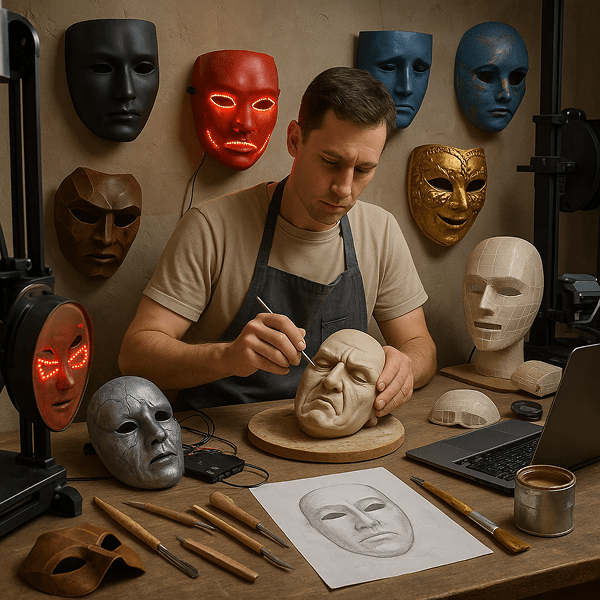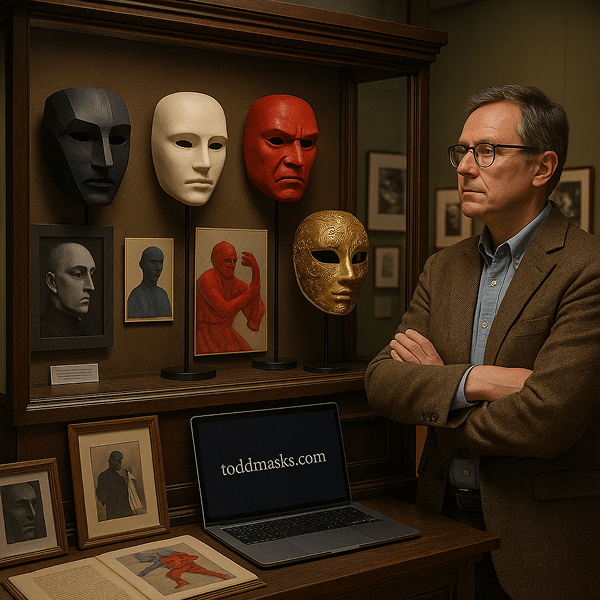Modern Theatre Masks — a dynamic evolution of centuries-old masquerade and performance traditions — are vital instruments in contemporary drama, dance, and experimental theatre. These masks are characterized by an extraordinary range of styles: from minimalist, monochrome designs to bold, geometric abstractions and ultra-realistic sculpted faces. Some are made with smooth, polished surfaces in metallic or vibrant hues, while others include exaggerated features or expressive cut-outs. Modern Theatre Masks are used worldwide, especially in Europe, North America, and East Asia, and their current forms emerged in the late 19th and 20th centuries, continuing to evolve alongside modern and postmodern artistic movements.
Historical Origins of Modern Theatre Masks
The emergence of Modern Theatre Masks is rooted in the dramatic reforms of late 19th-century Europe, when artists and directors sought to break free from naturalism and realism. The term “modern mask” refers to any mask created or adapted for theatrical use from the late 1800s onward, often influenced by symbolism, expressionism, and other avant-garde art currents. The etymology of “mask” comes from the Arabic “maskhara,” meaning buffoon, evolving through European languages to denote a disguise or face covering. Early modernists such as Edward Gordon Craig and Vsevolod Meyerhold pioneered the use of abstract, expressive masks to explore archetypal characters and the collective unconscious. In the 20th century, practitioners like Jacques Lecoq in France and Tadeusz Kantor in Poland developed new mask forms and pedagogies, emphasizing the body, movement, and visual storytelling. The influence of traditional forms — including Japanese Noh, Balinese Topeng, and Italian commedia dell’arte — was reimagined for modern audiences. Over time, technological advances introduced new materials and construction techniques, with masks now made from plastics, resin, fiberglass, and even digital media. Notably, Pantomime Masks, with their expressive neutrality, have contributed to the vocabulary of modern mask theatre.
Cultural Significance and Symbolism of Modern Theatre Masks
Modern Theatre Masks possess rich symbolic significance in their cultural context. In contemporary performance, the mask often serves as a tool for exploring universal themes — identity, alienation, transformation, and the boundaries between self and society. The neutrality or abstraction of modern masks allows performers to transcend individual identity and embody archetypes, emotions, or abstract concepts. In experimental theatre, masks are used to subvert expectations, disrupt narrative, or invite audience participation. The symbolism of the mask — hiding and revealing, protecting and exposing — resonates with modern audiences grappling with questions of authenticity, persona, and social roles. Myths and legends are often reinterpreted through the mask’s visual language, while some modern playwrights use masks to critique authority, tradition, or political power. The mask’s ability to silence the face and amplify the body brings a new dimension to both ritual and social commentary.
Materials and Craft Techniques of Modern Theatre Masks
Modern Theatre Masks are crafted from a diverse range of materials, reflecting both tradition and innovation. Common materials include fiberglass, resin, plastics, latex, metals, and advanced composites, offering durability, lightness, and versatility. Artisans may also use wood, leather, papier-mâché, or silicone for specific effects. The creation process typically involves sculpting a model in clay, casting a mold, and then producing the final mask, which may be painted, gilded, or airbrushed for dramatic effect. Special techniques such as laser cutting, 3D printing, or digital modeling allow for unprecedented precision and creativity. Decorative elements — metallic finishes, mirrored surfaces, LED lights, or embedded sound devices — can be incorporated to enhance the visual and theatrical impact. Color symbolism is often bold and deliberate: black and white for duality, red for passion, blue for melancholy, gold or silver for transcendence. Regional differences exist, with European masks often favoring minimalist or geometric designs, while Asian artists may blend traditional motifs with modern abstraction.

Functions and Uses of Modern Theatre Masks
Modern Theatre Masks are used in a wide variety of contexts — from ritual and ceremonial performances to avant-garde drama, dance, and multimedia installations. On stage, masks are employed to create striking visual imagery, enable rapid role changes, or evoke archetypal emotions. In contemporary dance and physical theatre, masks help performers focus on movement, body language, and nonverbal communication. Modern masks are also used in festivals, parades, site-specific performances, and immersive theatre experiences. Their role in educational settings is significant, aiding in actor training, improvisation, and creativity workshops. Over time, the use of modern masks has adapted to new technologies and performance styles — digital and projection masks, interactive installations, and virtual reality are now part of the theatrical mask landscape. Today, Modern Theatre Masks appear in everything from experimental opera to pop culture spectacles, reflecting their ongoing versatility and artistic relevance.
Regional Variations of Modern Theatre Masks
While modern mask theatre is a global phenomenon, regional styles and innovations abound. In France, Lecoq’s school has fostered a tradition of neutral and expressive masks for actor training and devised theatre. In Italy, companies blend commedia dell’arte influences with modern materials and forms. North American artists experiment with large, wearable sculptures and multimedia masks for street and experimental theatre. Eastern European and Russian performers often use masks to explore political and existential themes, drawing on a legacy of expressionist and constructivist art. In East Asia, artists incorporate elements from Noh, Kyogen, and Chinese opera into contemporary mask work, creating hybrid forms for new audiences. Each region adapts modern mask design to its own stories, social concerns, and artistic visions, resulting in a rich diversity of forms and aesthetics.
Famous Examples and Collections of Modern Theatre Masks
Famous Modern Theatre Masks can be found in museums, theatre archives, and private collections worldwide. Notable examples include the abstract masks of Edward Gordon Craig, Lecoq’s neutral and expressive masks, and the bold creations of Tadeusz Kantor. The Victoria and Albert Museum (London), Museo Internazionale della Maschera (Italy), and International Mask Museum (Mexico) house important collections. Photographic archives, costume sketches, and performance videos document the evolution of modern mask design. Online resources and digital galleries — such as toddmasks.com — offer virtual access to innovative and historic masks, providing inspiration and reference for practitioners and enthusiasts.

Influence of Modern Theatre Masks on Art and Culture
Modern Theatre Masks have had a profound impact on visual art, literature, cinema, and design. Their abstract and symbolic forms have inspired painters, sculptors, and filmmakers, from Picasso and Cocteau to contemporary installation artists. In literature, the mask is a metaphor for identity, secrecy, and the struggle between inner and outer worlds. Modern designers incorporate mask motifs into fashion, architecture, and stage sets, exploring the tension between tradition and innovation. The adaptation and reinvention of mask traditions play a crucial role in cultural preservation and creative experimentation, ensuring the mask’s continuing relevance in the digital age.
Contemporary Status and Preservation of Modern Theatre Mask Traditions
Today, Modern Theatre Masks are celebrated in theatres, festivals, and educational programs across the globe. Master mask-makers, theatre companies, and art schools preserve and expand the tradition, offering workshops, masterclasses, and collaborative projects. Contemporary artists experiment with new media, materials, and interdisciplinary approaches, bringing masks into dance, film, and digital art. Museums, universities, and platforms like toddmasks.com provide research, documentation, and virtual exhibitions for practitioners and the public. Ethical collecting, conservation, and knowledge-sharing are emphasized to ensure the vitality and accessibility of mask traditions for future generations.
Collecting and Acquiring Modern Theatre Masks
The market for Modern Theatre Masks is vibrant, with historic pieces, artist-signed works, and innovative contemporary designs available from mask-makers, galleries, and online platforms. Prices vary widely depending on craftsmanship, material, provenance, and artistic significance. Collectors are encouraged to seek expert advice, consider provenance and authenticity, and support ethical sources. Museums and theatre companies often offer certified reproductions and educational kits. Toddmasks.com provides expert guidance on collecting, authentication, and understanding the significance of modern mask art. Responsible collecting supports both artistic innovation and the preservation of mask heritage.
